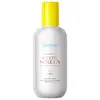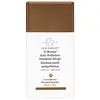Supergoop! Glowscreen Soft-Radiance Drops Mineral SPF 40 Versus Drunk Elephant D-Bronzi Anti-Pollution Sunshine Drops
What's inside
What's inside
 Key Ingredients
Key Ingredients

 Benefits
Benefits

 Concerns
Concerns

 Ingredients Side-by-side
Ingredients Side-by-side

Zinc Oxide 15.11%
Cosmetic ColorantWater
Skin ConditioningCaprylic/Capric Triglyceride
MaskingEthylhexyl Palmitate
EmollientPropanediol
SolventDimethicone
EmollientPolyglyceryl-3 Polyricinoleate
EmulsifyingSorbitan Isostearate
EmulsifyingPolyglyceryl-2 Dipolyhydroxystearate
Skin ConditioningFragaria Ananassa Seed Oil
AntioxidantPongamia Pinnata Seed Extract
Skin ConditioningClitoria Ternatea Flower Extract
Skin ConditioningPolyglyceryl-6 Polyricinoleate
EmulsifyingButylene Glycol
HumectantPolyhydroxystearic Acid
EmulsifyingPolysilicone-11
Inulin
Skin ConditioningMagnesium Sulfate
Triethoxycaprylylsilane
Sodium Phytate
Lecithin
EmollientIsopropyl Myristate
EmollientIsostearic Acid
CleansingGluconolactone
Skin ConditioningSodium Benzoate
MaskingCalcium Gluconate
HumectantIron Oxides
Titanium Dioxide
Cosmetic ColorantMica
Cosmetic ColorantZinc Oxide 15.11%, Water, Caprylic/Capric Triglyceride, Ethylhexyl Palmitate, Propanediol, Dimethicone, Polyglyceryl-3 Polyricinoleate, Sorbitan Isostearate, Polyglyceryl-2 Dipolyhydroxystearate, Fragaria Ananassa Seed Oil, Pongamia Pinnata Seed Extract, Clitoria Ternatea Flower Extract, Polyglyceryl-6 Polyricinoleate, Butylene Glycol, Polyhydroxystearic Acid, Polysilicone-11, Inulin, Magnesium Sulfate, Triethoxycaprylylsilane, Sodium Phytate, Lecithin, Isopropyl Myristate, Isostearic Acid, Gluconolactone, Sodium Benzoate, Calcium Gluconate, Iron Oxides, Titanium Dioxide, Mica
Water
Skin ConditioningHydrogenated Polyisobutene
EmollientGlyceryl Oleate Citrate
EmulsifyingMica
Cosmetic ColorantHydroxyethyl Acrylate/Sodium Acryloyldimethyl Taurate Copolymer
Emulsion StabilisingGlycerin
HumectantRibes Nigrum Seed Oil
EmollientSclerocarya Birrea Seed Oil
HumectantTheobroma Cacao Extract
Skin ConditioningCaprylic/Capric Triglyceride
MaskingVitis Vinifera Seed Extract
AntimicrobialLecithin
EmollientAcetyl Tetrapeptide-17
Skin ConditioningLinoleic Acid
CleansingLinolenic Acid
CleansingSorbitan Isostearate
EmulsifyingCamellia Sinensis Leaf Extract
AntimicrobialMaltodextrin
AbsorbentSodium Hyaluronate Crosspolymer
HumectantMagnolia Officinalis Bark Extract
AntimicrobialGlutamylamidoethyl Imidazole
Colloidal Platinum
AntimicrobialTocopherol
AntioxidantPhenoxyethanol
PreservativePentylene Glycol
Skin ConditioningSodium Benzoate
MaskingSorbic Acid
PreservativeCaprylyl Glycol
EmollientBoron Nitride
AbsorbentHexylene Glycol
EmulsifyingPolysorbate 60
EmulsifyingEthylhexylglycerin
Skin ConditioningCI 77491
Cosmetic ColorantCI 77492
Cosmetic ColorantCI 77499
Cosmetic ColorantSodium C14-16 Olefin Sulfonate
CleansingWater, Hydrogenated Polyisobutene, Glyceryl Oleate Citrate, Mica, Hydroxyethyl Acrylate/Sodium Acryloyldimethyl Taurate Copolymer, Glycerin, Ribes Nigrum Seed Oil, Sclerocarya Birrea Seed Oil, Theobroma Cacao Extract, Caprylic/Capric Triglyceride, Vitis Vinifera Seed Extract, Lecithin, Acetyl Tetrapeptide-17, Linoleic Acid, Linolenic Acid, Sorbitan Isostearate, Camellia Sinensis Leaf Extract, Maltodextrin, Sodium Hyaluronate Crosspolymer, Magnolia Officinalis Bark Extract, Glutamylamidoethyl Imidazole, Colloidal Platinum, Tocopherol, Phenoxyethanol, Pentylene Glycol, Sodium Benzoate, Sorbic Acid, Caprylyl Glycol, Boron Nitride, Hexylene Glycol, Polysorbate 60, Ethylhexylglycerin, CI 77491, CI 77492, CI 77499, Sodium C14-16 Olefin Sulfonate
 Reviews
Reviews

Ingredients Explained
These ingredients are found in both products.
Ingredients higher up in an ingredient list are typically present in a larger amount.
This ingredient is an emollient, solvent, and texture enhancer. It is considered a skin-softener by helping the skin prevent moisture loss.
It helps thicken a product's formula and makes it easier to spread by dissolving clumping compounds.
Caprylic Triglyceride is made by combining glycerin with coconut oil, forming a clear liquid.
While there is an assumption Caprylic Triglyceride can clog pores due to it being derived from coconut oil, there is no research supporting this.
Learn more about Caprylic/Capric TriglycerideLecithin is a term for a group of substances found in the cell membranes of plants, animals, and humans. They are made up of mixture of phospholipids.
This ingredient has emollient and emulsifying properties.
As an emollient, lecithen helps soften the skin and creates a barrier to keep moisture in.
As an emulsifier, it also helps prevent water and oil ingredients from separating. Lecithin can also help ingredients be better absorbed by the skin.
This is because the phospholipids in lecithin produce liposomes. Liposomes help other ingredients get through the skin barrier.
Depending on the source of this ingredient, lecithin may not be fungal acne safe. This is because some sources of lecithin come from soybean oil, which may feed the malassezia yeast that feeds fungal acne.
We recommend reaching out to the brand you are purchasing from to inquire about the source of their lecithin.
Some other names for this ingredient include soy lecithin and deoiled soy lecithin.
Learn more about LecithinMica is a naturally occurring mineral used to add shimmer and color in cosmetics. It can also help improve the texture of a product or give it an opaque, white/silver color.
Serecite is the name for very fine but ragged grains of mica.
This ingredient is often coated with metal oxides like titanium dioxide. Trace amounts of heavy metals may be found in mica, but these metals are not harmful in our personal products.
Mica has been used since prehistoric times throughout the world. Ancient Egyptian, Indian, Greek, Roman, Aztec, and Chinese civilizations have used mica.
Learn more about MicaSodium Benzoate is a preservative. It's used in both cosmetic and food products to inhibit the growth of mold and bacteria. It is typically produced synthetically.
Both the US FDA and EU Health Committee have approved the use of sodium benzoate. In the US, levels of 0.1% (of the total product) are allowed.
Sodium benzoate works as a preservative by inhibiting the growth of bacteria inside of cells. It prevents the cell from fermenting a type of sugar using an enzyme called phosphofructokinase.
It is the salt of benzoic acid. Foods containing sodium benzoate include soda, salad dressings, condiments, fruit juices, wines, and snack foods.
Studies for using ascorbic acid and sodium benzoate in cosmetics are lacking, especially in skincare routines with multiple steps.
We always recommend speaking with a professional, such as a dermatologist, if you have any concerns.
Learn more about Sodium BenzoateSorbitan Isostearate is an emulsifer and cleaning agent. It is created from isostearic acid and sorbitol.
As an emulsifier, Sorbitan Isostearate prevents oils and water from separating.
Due to its isostearic acid base, it may not be safe for Malassezia or fungal acne.
Learn more about Sorbitan IsostearateWater. It's the most common cosmetic ingredient of all. You'll usually see it at the top of ingredient lists, meaning that it makes up the largest part of the product.
So why is it so popular? Water most often acts as a solvent - this means that it helps dissolve other ingredients into the formulation.
You'll also recognize water as that liquid we all need to stay alive. If you see this, drink a glass of water. Stay hydrated!
Learn more about Water